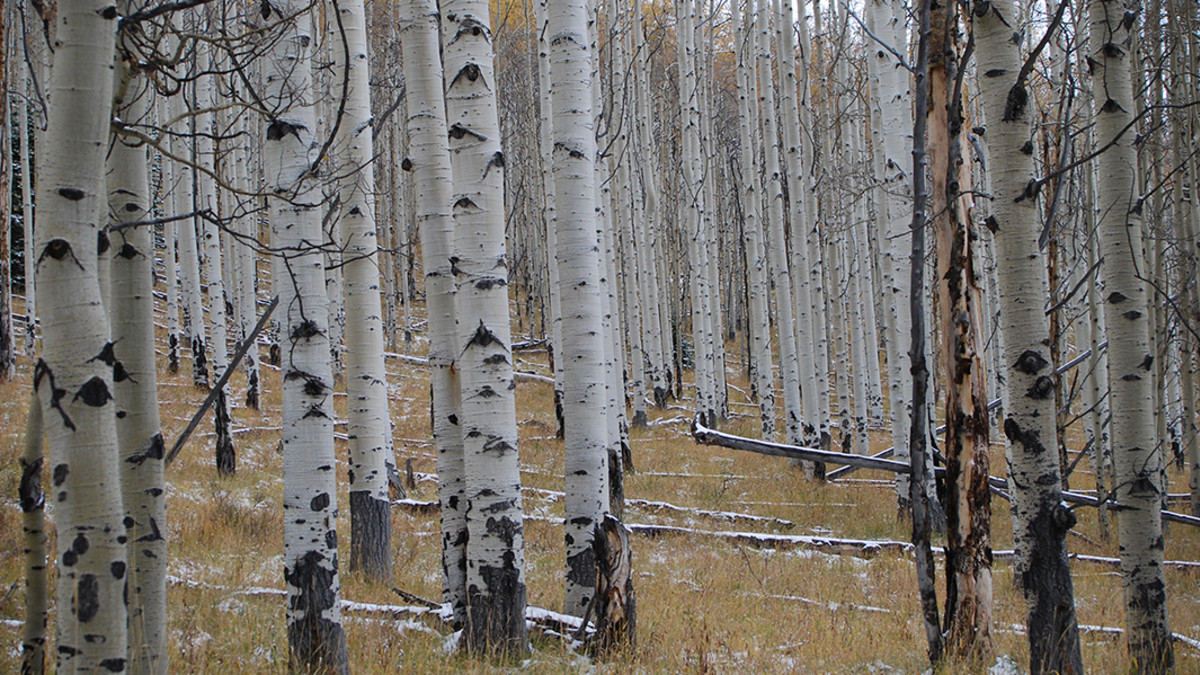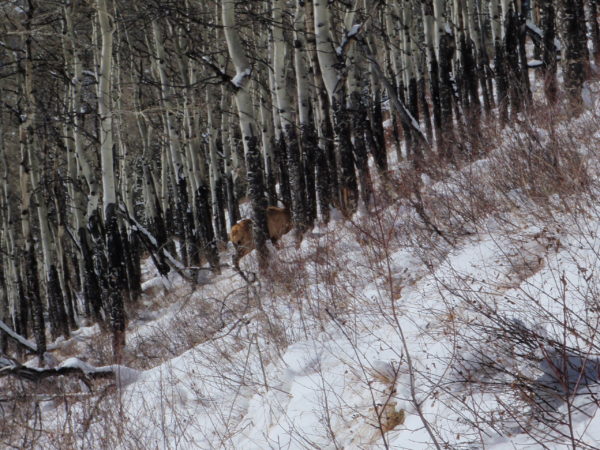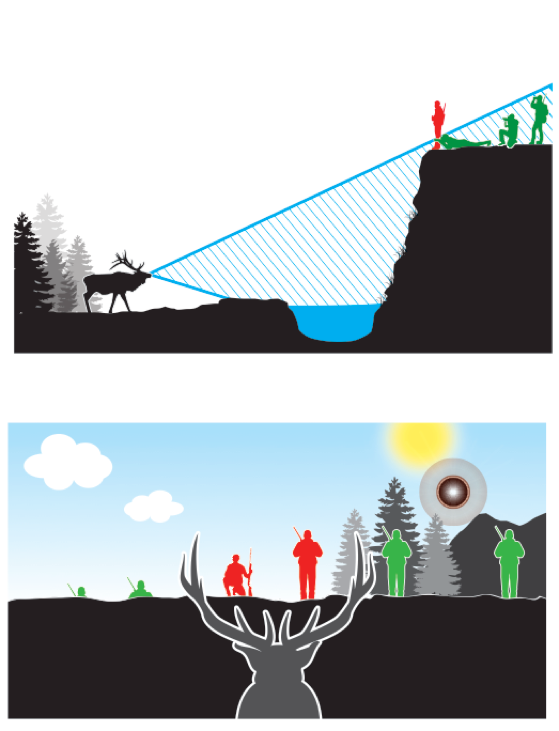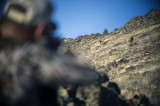
Still-hunting combines the simple pleasure of walking in the woods with the excitement and discipline of being on a hunt– let’s call it a perfected sneak. Because you could encounter your quarry at any moment, you need to maintain constant focus and move slowly and carefully enough that an animal might perceive you to be standing still.
It’s like being on the final leg of a careful stalk, except it lasts for hours and you’re never sure of the animal’s location until it’s time to raise your bow or rifle and shoot. It is this sense of the unknown that makes still-hunting so rewarding.
Along with stealth, route selection is one of the most important aspects of still hunting. In a general sense, your route should obviously take you through regions of good habitat that you identified through research and scouting. But on a more specific level, your route should take you through areas where you can travel quietly and enjoy enough visibility to see animals before you’re right on top of them.
The opposite of a good still-hunting route would be one that takes you through the bottom of a draw that’s covered with six inches of dry leaves and choked with head-high alders. Here you’re going to make a ton of noise and you won’t be able to see a thing.
Hunt the Edges
Conversely, edge habitats often provide quiet travel and good visibility. There are as many types of edges as there are types of terrain: where the dense forest meets open meadow; where alder thickets give way to alpine tundra; where swampland adjoins hardwood forests; where agricultural fields join heavy thickets; where riparian zones meet valley walls; where sage flats meet aspen stands.
Such places are animal magnets because they provide close proximity to both feeding areas and secure shelter areas. By working these areas, you’re likely to encounter animals that are moving back and forth between different habitat types or lingering along the edges. This is especially true during the low-light periods of morning and evening, when animals are most actively traveling between bedding and feeding areas.
Many ridgelines provide heavenly still-hunting conditions. Wind keeps the ground relatively free of leaves, and you’re looking at the country on both sides of you from an elevated angle. ATV trails and access roads that cut through feeding and bedding areas are also fantastic because you have quiet walking conditions and good visibility ahead of you. Active game trails can also be excellent, though things can happen almost too quickly if you happen to be moving against animal traffic in thick cover.
Managing human odor is a huge factor with still-hunting, and this is best done by playing the wind. This isn’t such a big deal for small-game or turkey hunters, but it’s of paramount importance to big game hunters. If the wind is blowing the same direction as you’re traveling, you’re at a tremendous disadvantage. Either wait for the wind to change or alter your line of travel.
Sun + Wind
It’s not that the wind needs to be directly in your face, but it should at least be at a 90-degree angle to your line of travel. In cross-wind situations, focus more effort on glassing and looking to the upwind side of your route, as downwind animals might have smelled you and then traveled into the wind to escape.
There’s an old saying , “May the wind always be at your back. May the sun shine warmly on your face.” Just as the wind portion of this saying is wrong for still-hunters, the sun portion has it completely backward as well. For reasons of visibility, both for your own and the animal’s, it is much better to have the sun at your back.
This way, your body is not brightly illuminated, yet there’s a better chance that your quarry will be well lit. What’s more, staring into the sun can be taxing on your eyes and it leads to diminished awareness on your part. However, if it comes down to having either the wind or the sun working on your behalf, go with the wind every time.
Optics of the Advantage
When still-hunting, you need to use your binoculars habitually. Too many hunters figure they can see everything just fine with the naked eye. Sadly for them, it’s just not true. Even at close distances of under a hundred yards, binoculars provide not only magnification of your vision but also a tightening of your focus that allows you to peer into small spaces where you might pick out the fine details of a leg, rump, or antler tine. But don’t focus on these small spaces at the expense of the bigger picture.
You need to alternate between detail work and broadscale scanning of the landscape ahead of you, alongside you, and even behind you. Since you never know where game will appear, you should expect it everywhere.

As hard as a still-hunter searches for his prey, his prey is searching ten times harder for predators. Every day of the animal’s life depends on its ability to spot trouble before it’s too late. You’re competing with the animal in a game of who-spots-who-first, and you need to do everything possible to swing the odds in your favor.
Still Hunting = Slow Hunting
First off, move slow. Take two or three steps and stop. Then take a few more steps and stop again. Give yourself plenty of time to listen. And whenever you start thinking that you’re moving slow enough, back it off even more.
You’ll find that walking slow takes practice; it’s a difficult thing to do, especially for energetic people who pride themselves on getting a lot done. It also takes a certain type of muscle control and concentration that aren’t really cultivated by normal life. At first you’ll find that you trip more often than you do when walking quickly, which is certainly strange. But stick with it and you’ll get better and better at slow movement.
Using Terrain to Your Advantage
The crest of the hill is all that’s needed to block the view of the elk and hide the hunters in the green positions; the hunter in the red position has skylined himself by standing right on the crest.
From the animal’s point of view, left to right: The first two hunters (in green) have stopped well short of the crest of the hill; they are mostly hidden by the horizon.
The middle hunters (in red) have approached too close to the crest of the hill and are now skylined. The two hunters on the right (in green) have advanced to the edge, but by keeping a backdrop (trees for one, and a close mountain for the other) they’ve kept themselves from becoming skylined.
Try to maintain a backdrop as you move along. Zigzag in such a way that you put trees, rocks, or brush behind you as much as possible. These things absorb your form and help keep you hidden. In areas of varied topography, avoid skylining yourself at all costs. A skylined human (that’s when you’re silhouetted against the sky) is very easy for animals to detect.
Be especially careful about this when hunting ridges and other high ground, but keep it in mind as well when hunting terrain with even minor ups and downs. Even a small rise in semi-timbered country can get you into trouble. Standing on it, you are not technically sky-lined since there are trees behind you, but your movement and presence are exaggerated and certainly more noticeable.
When you approach any sort of rise or promontory, be it a major ridge or the crest of a small swale, slow your speed down to that of a three-legged turtle. Every step you take increases your field of view immensely and all of this new terrain deserves close inspection.
Give your brain time to process the new ground. Depending on one’s abilities, it might take a minute or more for the brain to register that it’s looking at the back of a feeding deer and not just another grey rock.
By moving slowly as you travel around and over terrain features, you allow the terrain to camouflage your body. Even if an animal senses something and looks your way, it should only see you from the eyes up– and that might not be enough to alert it. But what will certainly alert the animal is the silhouette of a man, from the waist up, scrambling to get his rifle sling off his shoulder while muttering profanities because he should have moved slower and more carefully.
Silence is Deadly
The still-hunter must also deal with the issue of noise. In particular, hunters must be aware of making unnatural noises. Popping a stick with your boot is not the end of the world, since sticks pop in the woods all the time. But the sounds created by a thorn against canvas pants, or a velcro closure being torn open, or a bow limb smacking against a belt buckle are all unnatural. They will not go unnoticed by game.
The still-hunter’s footsteps should be the only noise he makes, and that noise should be minimal. You can diminish the sound of your footsteps by choosing routes that take you over soft vegetation, bare ground, and large rocks rather than dried leaves and loose gravel.
Also consider your footwear. Big, clunky mountaineering boots are not what you’re looking for. Instead, seek out light hikers or even trail runners when the weather permits. The soles of these shoes are much softer and quieter, and they’ll allow you to feel the ground under your feet. This way, you can sense impending noise-makers such as dry sticks and loose rocks before they give you away.
If you’re careful about movement and noise, you could get away with wearing a Santa Claus outfit in many still-hunting situations. That might sound funny, but it’s meant to emphasize the point that camouflage is not nearly as important as other basic principles of stealth.
However, you’ll never regret the use of camouflage clothing, and it might very well save you from getting busted by a prized animal. Regardless of whether you use camo or not, you should think about wearing gloves and a head net or face mask in order to hide the glare of your bare skin– especially white skin that might be shiny from sweat and natural oils.
Understanding the Elements
Weather conditions can have a serious impact on a still-hunter, and not always negative. Moisture from rain or melted snow is perfect for still-hunting, because it quiets the leaves and grass. But be careful during cold weather, because when that rain water freezes into a crust it becomes some of the loudest stuff you’ll ever traipse across.
High winds can also be beneficial. Besides loud metal-on-metal type noises, most sounds will be cancelled out by a fierce wind rattling every bush and leaf. And since every bush and branch is shaking and waving with the wind, your movements will blend in to those. And remember, animals don’t get the day off because it’s windy.
They will, however, alter their bedding locations. They look for the lee side of topographic features, and tend to bed in more open areas where they can see better. This is a plus for the still-hunter, as it makes game easier to spot from a distance.
Honing Your Mental Game
Your mental attitude is one last thing you should consider before enter the woods on a still-hunt. To keep the heightened level of focus needed for still-hunting success, you need an optimistic and positive frame of mind. By always believing your quarry is just around the corner or just over the next rise, you’ll keep your eyes working for the duration of the hunt.
The moment that pessimistic thoughts like, I picked the wrong spot, or I should’ve gone somewhere else instead, enter your head, you’ll sling your rifle over your shoulder and take a few careless steps. Just then, the bedded buck you worked so hard to sneak in range of will bust out from a thicket and leave you standing there to contemplate whatever it was that distracted you from the work of hunting.
A Handful of Extra Tips for the Still-Hunter
- Because bumping into animals is an inherent part of still-hunting, the hunter must be always ready to make a quick shot. Carrying your weapon in the cross-body field position instead of slung on your shoulder will shave a precious second or two of your response time. But don’t discard your sling altogether. It’ll come in handy when scrambling up a steep face, crawling through a thicket, or any other time when you need both hands.
- Even the best still-hunter will inadvertently spook game. To capitalize on this reality, the friends and family of a Wisconsin deer hunter named Doug Duren have perfected a still-hunting variation that they call mooching. On a mooch, two or more hunters coordinate their still hunts in hopes of bumping deer towards one another.
- Another still-hunting variation is to add calling to your hunt. A South Carolina deer hunter named Robert Abernathy will stop every couple hundred yards on a still-hunt in order to do a rattling sequence. Even if a buck doesn’t come charging in to the sound of the rattling antlers, the hunter might still encounter the animal during the course of his hunt. The same strategy can be applied to many species besides deer.
- It’s easy for big game to pick out the rhythm of human footsteps. When walking on noisy ground, walk in an arrhythmic pattern and never take more than three or four steps at a time between pauses.
- Turn your scope to its lowest magnification setting when on a still-hunt. This will help you find your target faster, especially at close range.
- Use your nose to sense what’s ahead of you. Many critters, especially elk, wild pigs, and javelina have pungent odors that you can sometimes smell long before your eyes find the animal.






